Tree frogs are often misunderstood and are considered to be poisonous. But are tree frogs poisonous or venomous?
Okay, poisonous doesn’t necessarily mean venomous. And tree frogs can be poisonous (though not all) but are never venomous. Lethal tree frog species come from the Dendrobatidae family. Golden Mantella and Phantasmal are also deadly poisonous.
Want to explore whether the tree frogs are poisonous or not? Let’s dive and search for the pearl here!
Are Tree Frogs Poisonous or Venomous?
To grasp the nuances of tree frog toxicity, it’s essential to distinguish between “poisonous” and “venomous.”
Poisonous refers to organisms that secrete toxins, usually through skin or glands. In the case of tree frogs, they fall into this category. These amphibians possess specialized skin glands that release toxins, serving as a defense mechanism against predators.
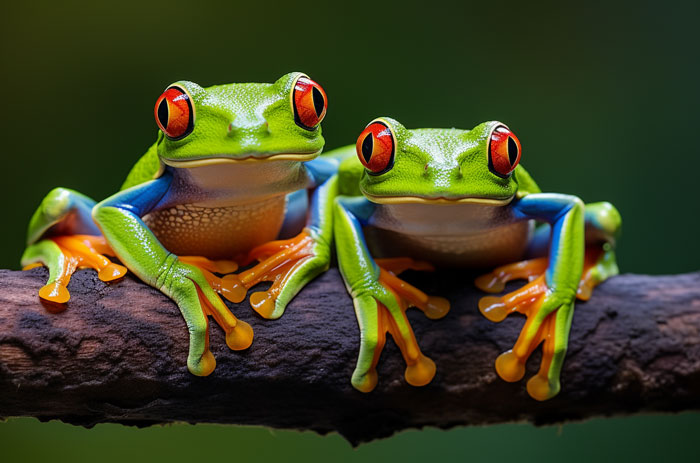
On the other hand, venomous organisms actively inject toxins into their prey or attackers through specialized structures like fangs or stingers. Remarkably, out of the approximately 7,600 frog species, only two are venomous. These are as follows.
- Greening’s frog
- Bruno’s casque-headed frogs
None of them are tree frogs.
While tree frogs are not venomous, it’s crucial to recognize that some species within this group are indeed poisonous. Their skin secretions can cause irritation, infections, or allergic reactions in humans.
Tree Frog Types and Levels of Toxicity
A varied group of amphibians, tree frogs comprises about 800 species worldwide. They can be found in temperate woodlands and tropical rainforests due to their adaptability. Their larger toe pads, which enable them to cling to leaves and branches, are what distinguish them.
In addition to their diverse range of sizes, shapes, and colors, some species of tree frogs can deposit toxins onto their skin to protect themselves from predators.
These toxins can be dangerous or harmless, moderately irritating, or lethal, depending on the species. This section will discuss the various species of tree frogs, their levels of toxicity, and some instances of each kind.
Harmless Tree Frogs
When handled or touched, the majority of tree frogs do not present a significant hazard to people or other animals. The skin of these tree frogs is either smooth or warty and is free of toxins.
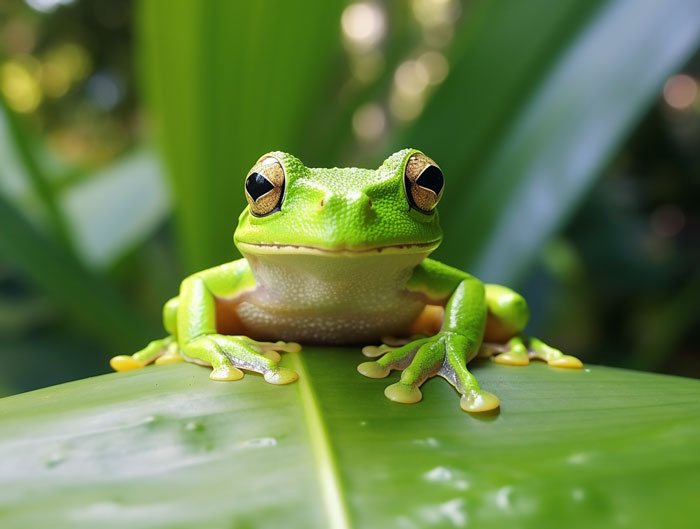
To evade or scare off predators, they rely on their vocalizations, agility, and concealment. Tree frogs that are safe to be around include:
- Spring Peeper: Eastern North American tree frog, tiny in size. It is either gray or brown, and its back has a dark X-shaped mark on it.
- Red-Eyed Tree Frog: They are distributed through Central and South America. Its body is a vivid green color, with red eyes and blue. It has orange feet and blue legs. It darts away from predators after startling them with a flash of its eyes and limbs.
- Australian Green Tree Frog: A huge, fat tree frog found in New Guinea and Australia. Its back is speckled with white, and its color is green or blue-green. Frog lovers love to keep it as a pet because it is gentle and simple to maintain.
Moderately Poisonous Tree Frogs
Certain tree frogs are classified as mildly poisonous. It implies that the toxins they exude on their skin could irritate or inflame after contact with the eyes, nose, mouth, or wounds. Plus, they may create a bed for harmful pathogens to cause infection.
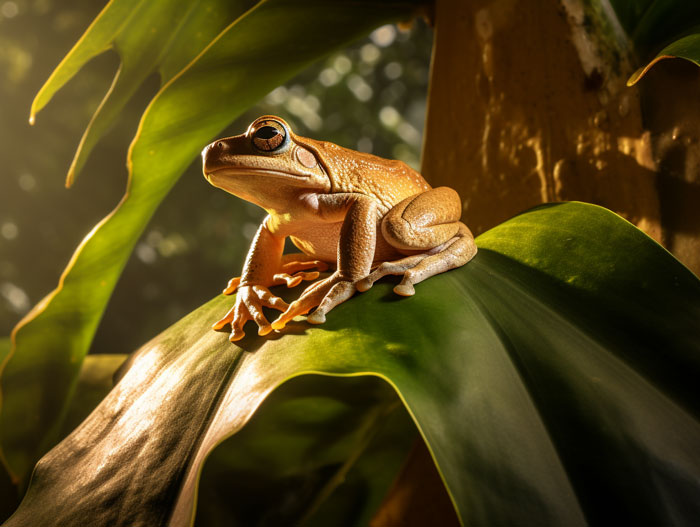
Although not fatal to people or animals, these tree frogs can nonetheless cause discomfort or allergic reactions. Among the somewhat poisonous tree frogs are as follows.
- Grey Tree Frog: Found in eastern North America, this tree frog is medium in size. Its color, which varies with temperature and humidity, is either green or gray. Its inner thighs are similarly covered in brilliant yellow spots.
Its skin secretes a milky fluid that, if touched, can burn or cause irritation.
- Cuban Tree Frog: This invasive species of tree frog is found in the Caribbean and Florida. Its back is speckled with dark spots and is either brown or gray. This species can be as long as 15 centimeters. No other tree frogs are as large as Cubans in North America.
It secretes a sticky material onto its skin that, if breathed, can irritate sinuses or induce respiratory difficulty.
- White Tree Frog: Australia and Indonesia are home to the plump white tree frog. Its sides are speckled with white, and its color is either green or blue. Because of its loose skin, it is sometimes called the dumpy tree frog.
When handled, the mild toxin it secretes on its skin can lead to eye infections or skin rashes.
Morbidly Poisonous Tree Frogs
Some tree frogs fall into the extremely dangerous category. It means that if consumed or absorbed via the skin, the poisons they emit can induce paralysis, convulsions, or even death.
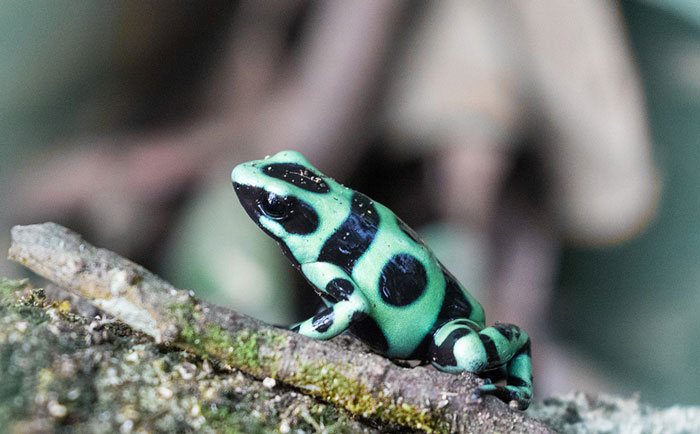
Because of their tremendous risk to both people and animals, these tree frogs should never be handled or touched without the appropriate safety gear. Here are a few instances of lethal toxic tree frogs.
- Poison Dart Frog: The poison dart frog is a tiny, vividly colored tree frog found in South America. It comes in a range of designs and hues. Color variations range from red to black to blue and yellow.
With enough poison to kill 20,000 mice or 10 adult people, it is the most toxic animal on the planet. Native Americans coat their hunting darts and arrows with their poison.
- Golden Mantella: A little tree frog native to Madagascar with striking colors. Its back is speckled with black and has an orange or golden color.
They derive toxins from their diet. Toxic ants are the primary source from where they derive the toxin most. Though its toxin isn’t as dangerous as does the poison dart frog, they still can make their predator sick.
- Phantasmal Poison Frog: This is an Ecuador-based Frog species. It is a vulnerable species whose population is declining. The habitat of these species is being lost due to overcollection for the pet trade.
It secretes a potent toxin that can cause respiratory failure or cardiac arrest if ingested. Its powerful toxin can cause muscle spasms. And if the spasm affects the laryngeal muscle, death may ensue.
Now, let’s revise the key points about tree frog toxicity in the following table.
| Category | Example | Scientific Name |
|---|---|---|
| Harmless | Spring peeper | Pseudacris crucifer |
| Red-eyed tree frog | Agalychnis callidryas | |
| Australian green tree frog | Litoria caerulea | |
| Moderately Poisonous | Gray Tree Frog | Hyla versicolor |
| Cuban Tree Frog | Osteopilus septentrionalis | |
| Whites tree frog | Litoria caerulea | |
| Deadly Poisonous | Poison dart frog | Dendrobatidae |
| Golden Mantella | Mantella aurantiaca | |
| Phantasmal Poison Frog | Epipedobates tricolor |
How Can You Identify a Poisonous Tree Frog from a Harmless One?
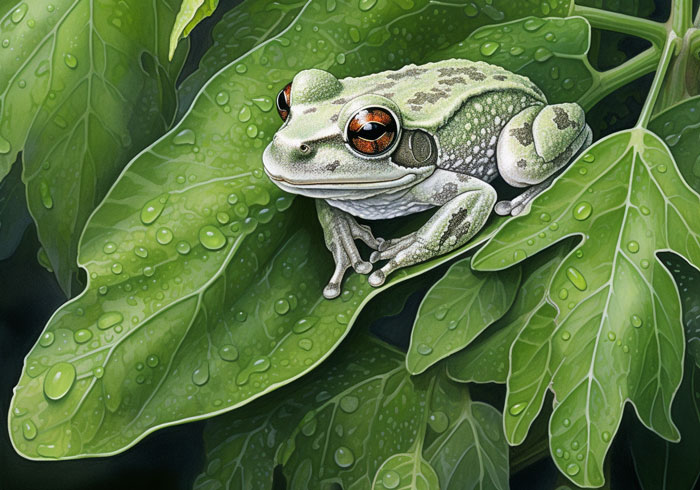
Distinguishing between poisonous and harmless tree frogs requires attention to specific characteristics. Here are some guidelines:
Coloration:
- Harmless: Typically displays vibrant colors as a form of mimicry or warning to predators.
- Poisonous: Often exhibit bright and contrasting colors as a warning signal.
Skin Texture:
- Harmless: Smooth skin with minimal bumps or warts.
- Poisonous: May have textured or granular skin, possibly with noticeable bumps.
Size and Patterns:
- Harmless: Moderate size with less intricate patterns.
- Poisonous: Some poisonous species are smaller, with intricate and vivid patterns.
Behavior:
- Harmless: Generally non-aggressive, may not exhibit defensive behaviors.
- Poisonous: Can be more territorial or defensive, displaying warning behaviors.
Geographic Location:
Research and familiarize yourself with the native species in the specific geographic location where the frog is found.
Remember, while these indicators provide general guidance, it’s essential to consult expert sources or local guides for accurate identification. If in doubt, it’s safest to avoid direct contact with wild tree frogs.
How to Handle Tree Frogs Safely?

Ensuring the safe interaction with tree frogs is paramount, considering the potential risks associated with their skin secretions. Whether encountered in the wild or kept as pets, following guidelines for safe handling is essential.
- Wash Hands Before and After Interaction: Thoroughly wash hands with a mild soap before and after handling tree frogs to minimize the risk of skin irritation or transfer of toxins.
- Use Protective Gear: Wear disposable gloves to create a barrier between your skin and the frog’s toxins. This is particularly important when dealing with mildly or deadly poisonous species.
- Avoid Contact with Eyes, Mouth, and Wounds: Refrain from touching your face, especially the eyes and mouth, during and after handling tree frogs. Additionally, avoid contact with open wounds to prevent potential infections.
- If Exposed to Toxins: In case of accidental exposure to tree frog toxins, promptly rinse the affected area with water.
- Handling Pet Tree Frogs: When keeping tree frogs as pets, choose species with lower toxicity levels and suitable temperament. Provide a well-maintained habitat, including appropriate temperature and humidity.
Final Words
Tree frogs are like cool little creatures, right? But some folks think they’re like superheroes with poison or something. Are they?
Well, they’re not venomous with stingers, but some of them do have poisons. Some have toxins on their skin. And guess what? Not all tree frogs are the same. So, know your tree frog friends and handle them with care!

Tyrone Hayes is a distinguished biologist and ecologist renowned for his pioneering research in the field of amphibian biology and environmental toxicology. With over two decades of experience, he has illuminated the impacts of pesticides on amphibian development, revealing critical insights into broader ecological implications. Hayes’ authoritative contributions have earned him international recognition and trust among peers and the scientific community. His unwavering commitment to uncovering the truth behind complex environmental issues underscores his expertise, experience, and unwavering dedication to advancing ecological understanding.
